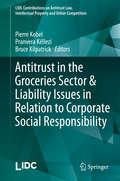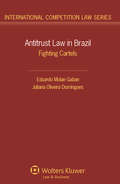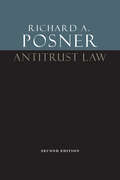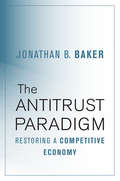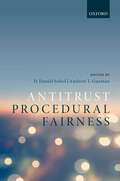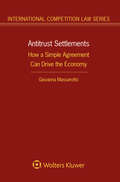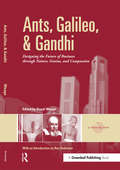- Table View
- List View
Antitrust in the Groceries Sector & Liability Issues in Relation to Corporate Social Responsibility (LIDC Contributions on Antitrust Law, Intellectual Property and Unfair Competition)
by Pierre Kobel Pranvera Këllezi Bruce KilpatrickThe book provides an analysis of the grocery retail market in a very large number of countries with an international report written by an economist. The second part of the book offers the analysis of liability issues in relation to non-compliance with CSRs with an international report by a British barrister. Both topics are very timely.
Antitrust Institutions and Policies in the Globalising Economy (International Political Economy Series)
by Eleonora PoliEleonora Poli analyses how ideas and material interests have come to determine the evolution of antitrust policies in the USA, EU, Japan and BRICS. She argues that three major economic crises together with market globalisation have changed governments' perceptions of market competition, giving rise to a neo-liberal global phase.
Antitrust Law in Brazil: Fighting Cartels
by Eduardo Molan Gaban and Juliana Oliveira DominguesThis book highlights the case of Brazil, a major economic player among developing countries. In seventeen years of enforcing the Brazilian Antitrust Law, Brazil’s Administrative Council for Economic Defence (CADE) has achieved outstanding results and has been recognized as the most effective antitrust enforcement agency in the developing world. This book is the first to describe and analyse the workings and case law of the CADE, emphasizing the agency’s fundamental methodology and focusing on the contributory roles of such factors as the following: mechanisms and procedures of enforcement of the Antitrust Law in Brazil; methodologies (tests) used for antitrust assessment (for merger and conduct controls); evaluation of barriers to entry and rivalry in analysed markets; assessment of proof and circumstantial evidence within CADE case law and court decisions; examination of rational justifications for practices under investigation; legality of exchange of information; leniency agreements; cease and desist agreements; cultural issues and modifications; civil and criminal enforcement; private damages considerations; and the role of international and regional competition law regimes (OECD, UNCTAD, WTO, ICN, Mercosur). The book’s consolidated research on Brazil’s cartel investigations clearly describes the main defence theories and the courts’ decisions. The authors also explore the relationship of Brazil’s antitrust law to the country’s public policies in the areas of consumer rights, public procurement, and measures against corruption, with special emphasis on the synergies arising from antitrust law and consumer protection. It is worth noting that the studies carried out in this book discussed Law No. 8884/94 (Brazilian Antitrust Law) and the New Brazilian Antitrust Law, which was passed on 5 October 2011 and which will be enforced in 2012. With its unique synthesis of constitutional law, comparative antitrust law, and CADE’s case law, this book will be welcomed by competition lawyers and other parties interested in methods and procedures used in merger and conduct control, and especially in anti-cartel enforcement, in developing countries.
Antitrust Law, Second Edition
by Richard A. PosnerWhen it was first published a quarter of a century ago, Richard Posner's exposition and defense of an economic approach to antitrust law was a jeremiad against the intellectual disarray that then characterized the field. As other perspectives on antitrust law have fallen away, Posner's book has played a major role in transforming the field of antitrust law into a body of economically rational principles largely in accord with the ideas set forth in the first edition. Today's antitrust professionals may disagree on specific practices and rules, but most litigators, prosecutors, judges, and scholars agree that the primary goal of antitrust laws should be to promote economic welfare, and that economic theory should be used to determine how well business practices conform to that goal. In this thoroughly revised edition, Posner explains the economic approach to new generations of lawyers and students. He updates and amplifies his approach as it applies to the developments, both legal and economic, in the antitrust field since 1976. The "new economy," for example, has presented a host of difficult antitrust questions, and in an entirely new chapter, Posner explains how the economic approach can be applied to new industries such as software manufacturers, Internet service providers, and those that provide communications equipment and services. "The antitrust laws are here to stay," Posner writes, "and the practical question is how to administer them better-more rationally, more accurately, more expeditiously, more efficiently." This fully revised classic will continue to be the standard work in the field.
Antitrust Law, Second Edition
by Richard A. PosnerWhen it was first published a quarter of a century ago, Richard Posner's exposition and defense of an economic approach to antitrust law was a jeremiad against the intellectual disarray that then characterized the field. As other perspectives on antitrust law have fallen away, Posner's book has played a major role in transforming the field of antitrust law into a body of economically rational principles largely in accord with the ideas set forth in the first edition. Today's antitrust professionals may disagree on specific practices and rules, but most litigators, prosecutors, judges, and scholars agree that the primary goal of antitrust laws should be to promote economic welfare, and that economic theory should be used to determine how well business practices conform to that goal. In this thoroughly revised edition, Posner explains the economic approach to new generations of lawyers and students. He updates and amplifies his approach as it applies to the developments, both legal and economic, in the antitrust field since 1976. The "new economy," for example, has presented a host of difficult antitrust questions, and in an entirely new chapter, Posner explains how the economic approach can be applied to new industries such as software manufacturers, Internet service providers, and those that provide communications equipment and services. "The antitrust laws are here to stay," Posner writes, "and the practical question is how to administer them better-more rationally, more accurately, more expeditiously, more efficiently." This fully revised classic will continue to be the standard work in the field.
Antitrust Law, Second Edition
by Richard A. PosnerWhen it was first published a quarter of a century ago, Richard Posner's exposition and defense of an economic approach to antitrust law was a jeremiad against the intellectual disarray that then characterized the field. As other perspectives on antitrust law have fallen away, Posner's book has played a major role in transforming the field of antitrust law into a body of economically rational principles largely in accord with the ideas set forth in the first edition. Today's antitrust professionals may disagree on specific practices and rules, but most litigators, prosecutors, judges, and scholars agree that the primary goal of antitrust laws should be to promote economic welfare, and that economic theory should be used to determine how well business practices conform to that goal. In this thoroughly revised edition, Posner explains the economic approach to new generations of lawyers and students. He updates and amplifies his approach as it applies to the developments, both legal and economic, in the antitrust field since 1976. The "new economy," for example, has presented a host of difficult antitrust questions, and in an entirely new chapter, Posner explains how the economic approach can be applied to new industries such as software manufacturers, Internet service providers, and those that provide communications equipment and services. "The antitrust laws are here to stay," Posner writes, "and the practical question is how to administer them better-more rationally, more accurately, more expeditiously, more efficiently." This fully revised classic will continue to be the standard work in the field.
Antitrust Law, Second Edition
by Richard A. PosnerWhen it was first published a quarter of a century ago, Richard Posner's exposition and defense of an economic approach to antitrust law was a jeremiad against the intellectual disarray that then characterized the field. As other perspectives on antitrust law have fallen away, Posner's book has played a major role in transforming the field of antitrust law into a body of economically rational principles largely in accord with the ideas set forth in the first edition. Today's antitrust professionals may disagree on specific practices and rules, but most litigators, prosecutors, judges, and scholars agree that the primary goal of antitrust laws should be to promote economic welfare, and that economic theory should be used to determine how well business practices conform to that goal. In this thoroughly revised edition, Posner explains the economic approach to new generations of lawyers and students. He updates and amplifies his approach as it applies to the developments, both legal and economic, in the antitrust field since 1976. The "new economy," for example, has presented a host of difficult antitrust questions, and in an entirely new chapter, Posner explains how the economic approach can be applied to new industries such as software manufacturers, Internet service providers, and those that provide communications equipment and services. "The antitrust laws are here to stay," Posner writes, "and the practical question is how to administer them better-more rationally, more accurately, more expeditiously, more efficiently." This fully revised classic will continue to be the standard work in the field.
Antitrust Law, Second Edition
by Richard A. PosnerWhen it was first published a quarter of a century ago, Richard Posner's exposition and defense of an economic approach to antitrust law was a jeremiad against the intellectual disarray that then characterized the field. As other perspectives on antitrust law have fallen away, Posner's book has played a major role in transforming the field of antitrust law into a body of economically rational principles largely in accord with the ideas set forth in the first edition. Today's antitrust professionals may disagree on specific practices and rules, but most litigators, prosecutors, judges, and scholars agree that the primary goal of antitrust laws should be to promote economic welfare, and that economic theory should be used to determine how well business practices conform to that goal. In this thoroughly revised edition, Posner explains the economic approach to new generations of lawyers and students. He updates and amplifies his approach as it applies to the developments, both legal and economic, in the antitrust field since 1976. The "new economy," for example, has presented a host of difficult antitrust questions, and in an entirely new chapter, Posner explains how the economic approach can be applied to new industries such as software manufacturers, Internet service providers, and those that provide communications equipment and services. "The antitrust laws are here to stay," Posner writes, "and the practical question is how to administer them better-more rationally, more accurately, more expeditiously, more efficiently." This fully revised classic will continue to be the standard work in the field.
Antitrust Law, Second Edition
by Richard A. PosnerWhen it was first published a quarter of a century ago, Richard Posner's exposition and defense of an economic approach to antitrust law was a jeremiad against the intellectual disarray that then characterized the field. As other perspectives on antitrust law have fallen away, Posner's book has played a major role in transforming the field of antitrust law into a body of economically rational principles largely in accord with the ideas set forth in the first edition. Today's antitrust professionals may disagree on specific practices and rules, but most litigators, prosecutors, judges, and scholars agree that the primary goal of antitrust laws should be to promote economic welfare, and that economic theory should be used to determine how well business practices conform to that goal. In this thoroughly revised edition, Posner explains the economic approach to new generations of lawyers and students. He updates and amplifies his approach as it applies to the developments, both legal and economic, in the antitrust field since 1976. The "new economy," for example, has presented a host of difficult antitrust questions, and in an entirely new chapter, Posner explains how the economic approach can be applied to new industries such as software manufacturers, Internet service providers, and those that provide communications equipment and services. "The antitrust laws are here to stay," Posner writes, "and the practical question is how to administer them better-more rationally, more accurately, more expeditiously, more efficiently." This fully revised classic will continue to be the standard work in the field.
The Antitrust Paradigm: Restoring a Competitive Economy
by Jonathan B. BakerAt a time when tech giants have amassed vast market power, Jonathan Baker shows how laws and regulations can be updated to ensure more competition. The sooner courts and antitrust enforcement agencies stop listening to the Chicago school and start paying attention to modern economics, the sooner Americans will reap the benefits of competition.
Antitrust Procedural Fairness
by D. Daniel Sokol and Andrew T. GuzmanMuch of antitrust law scholarship has focused on substantive legal issues - theories of harm and changing law and policy. Surprisingly, there has been very little work that is comparative, on a fundamental element that is a critical building block to effective policy - procedural fairness. Procedural fairness encompasses issues of transparency and due process. Procedural fairness has been an important issue in global antitrust for some time. The types of due process concerns raised globally often relate to the lack of effective representation, the use of industrial policy by third parties, and procedural tools that do not allow for the most effective advocacy to lead to efficient outcomes. This book focuses on these issues and teases out common problems and distinct issues in particular jurisdictions, allowing for a rethink of creating a more effective system for procedural fairness, and explores these issues in each jurisdiction, along with highlights of particular cases in which due process issues have emerged.
Antitrust Procedural Fairness
Much of antitrust law scholarship has focused on substantive legal issues - theories of harm and changing law and policy. Surprisingly, there has been very little work that is comparative, on a fundamental element that is a critical building block to effective policy - procedural fairness. Procedural fairness encompasses issues of transparency and due process. Procedural fairness has been an important issue in global antitrust for some time. The types of due process concerns raised globally often relate to the lack of effective representation, the use of industrial policy by third parties, and procedural tools that do not allow for the most effective advocacy to lead to efficient outcomes. This book focuses on these issues and teases out common problems and distinct issues in particular jurisdictions, allowing for a rethink of creating a more effective system for procedural fairness, and explores these issues in each jurisdiction, along with highlights of particular cases in which due process issues have emerged.
Antitrust Settlements: How a Simple Agreement Can Drive the Economy
by Giovanna MassarottoCompetition enforcement authorities use settlements as a tool to ensure compliance with antitrust law. Companies can make commitments to remedy breaches, ensuring that they avoid litigation and potential fines and reputational damage. The author of this highly original and innovative book shows that, rather than fines or arguing principles of competition law in litigation, antitrust settlements (namely U.S. consent decrees and EU commitment decisions) hold the key to globally effective enforcement, particularly in the digital and blockchain era. Antitrust law does not necessarily need to be abolished, but rather should be fully exploited as an economic regulation led by antitrust settlements. In supporting her thesis, the author examines such elements of competition enforcement as the following: drawbacks of allowing the courts to regulate markets; whether antitrust settlements sacrifice antitrust deterrence; how settlements rapidly and surgically regulate markets; comparative analysis between U.S. consent decrees and EU commitment decisions; economic analysis on the adoption of antitrust settlements in both the U.S. and EU markets from 2013 to 2018; fundamental role of antitrust settlements in regulating the current digital markets; and comprehensive description on how to use antitrust settlements to regulate the data industry. With its thorough guidance on U.S. consent decrees and EU commitment decisions from their functioning to their characteristics and procedure—and its extensive treatment of the main antitrust remedies available and used in enforcing of antitrust law in both the U.S. and EU—the book provides both an economic and a legal analysis of the functioning and the scope of antitrust settlements. It assesses the influence of decisions on companies’ behavior and agencies’ practice, using economic analysis to show the procompetitive or anticompetitive effects of remedies, with special attention to digital markets. Because markets have become so dynamic and unpredictable that is difficult to preserve efficiency, the author says, there is a little room for law—economic regulation is a better fit. This book is a springboard to further investigate how a simple antitrust enforcement tool, having turned competition law into an economic regulation policy, can drive our economy, leading both the antitrust and regulatory interventions in tackling today’s market challenges.
Antitrust, the Market and the State: Contributions of Walter Adams
by James W. Brock Kenneth G. ElzingaUsing the metaphor of the socially constructed organization of space, this text takes a broad view of the evolution of urban America, from its historical roots to the present. It examines how policies respond to and affect the organization of space, and it looks to the future of American cities.
Antitrust, the Market and the State: Contributions of Walter Adams
by James W. Brock Kenneth G. ElzingaUsing the metaphor of the socially constructed organization of space, this text takes a broad view of the evolution of urban America, from its historical roots to the present. It examines how policies respond to and affect the organization of space, and it looks to the future of American cities.
Antonio de Viti de Marco: A Story Worth Remembering
by Manuela MoscaThis book provides insight into the remarkable life and work of the Italian economist Antonio de Viti de Marco (1858-1943). This book presents eleven interviews with American and Italian scholars from various disciplines that provide a profile of this major intellectual as an economic theorist, politician, and individual. He was the founder of the pure theory of Public Finance, played an important role in the foundation of Public Choice, and was also a staunch liberal and radical politician. An English translation of one of his books, made as early as 1936, greatly influenced James M. Buchanan, Nobel prize-winner for economics.
Antonio Serra and the Economics of Good Government (Palgrave Studies in the History of Finance)
by Rosario Patalano Sophus ReinertIn this book some of the world's leading economists and experts on Serra explore the enduring appeal of his 1613 Breve trattato.
Ants, Galileo, and Gandhi: Designing the Future of Business through Nature, Genius, and Compassion
by Sissel Waage Ray AndersonAlthough sustainability efforts in business are still a work in progress, it is increasingly clear that key elements of a new generation of enterprises will be radically different from those of our contemporary modern industrial economy. The core distinctions between what currently exists and what is being created are communicated in this book through the compelling metaphor of Ants, Galileo, and Gandhi. This collection, developed from The Natural Step's conference on Sustainability and Innovation in 2002, provides radical ideas for generating a new perspective on the dynamics of business systems. "Ants" symbolise the lessons to be learned from nature and the dependence of individual beings on broader, complex systems. "Galileo" embodies brilliance in perceiving and proving that the current paradigm is flawed. 'Gandhi' exemplifies exceptional compassion in fighting for fundamental change. All of these attributes are increasingly relevant in a world where, globally, we are experiencing both a steady decline in life-supporting resources and rising demands. Recognition of these challenges is sparking innovation within the private sector where the first glimmers of systemic change can be seen. The book examines the emergence of 21st-century enterprises that recognise their reliance on broad social and ecological systems ("ants"), incorporate sparks of genius rooted in rigorous analyses ("Galileo"), and acknowledge the importance of compassion and determination within any endeavour ("Gandhi"). With contributions from Ray Anderson, Gretchen Daily, Karl-Henrik Rob
Anwenderakzeptanz unternehmensweiter Standardsoftware: Theorie, Einflussfaktoren und Handlungsempfehlungen
by Oliver KohnkeMit einer theoretisch fundierten Untersuchung der Einflussfaktoren auf die Anwenderakzeptanz von Standardsoftware behandelt Oliver Kohnke ein höchst praxisrelevantes Thema. An der Schnittstelle zwischen IT und Psychologie nutzt er ein erweitertes „Technology Acceptance Model (TAM)“, um zu analysieren, wie Anwenderakzeptanz entsteht und gezielt beeinflusst werden kann. Dabei liefert der Autor für den deutschsprachigen Raum erstmals eine zusammenfassende Darstellung des Forschungsstands zum TAM und reflektiert das Modell kritisch vor dem Hintergrund aktueller sozialpsychologischer Erkenntnisse. Die Datenerhebung erfolgte im Rahmen mehrerer internationaler Studien, davon eine Längsschnittstudie. Aufgrund der großen Stichproben konnte der Autor anspruchsvolle statistische Verfahren einsetzen, die er umfassend erläutert
Anwenderorientierte Dezentralisierung von PPS-Systemen (fir+iaw Forschung für die Praxis #39)
by Götz-Andreas Kemmner0 d EDV-Systeme zur Produktionsplanung und -steuerung (PPS-Systeme) stellen heute ein unabdingbares Hilfsmittel zur organisatorischen Rationalisierung dar. Zentral organisierte PPS-Systeme sind inzwischen an die Grenzen ihrer Leistungsfähigkeit gestoßen. Dezentrale, auf mehrere Subsysteme verteilte PPS-Systeme können auch den zukünftigen Anforderungen der Praxis gerecht werden. Bisherige Verfahren zur Konzipierung dezentraler PPS-Systeme richten sich primär nach den Belangen der EDV-Technologie. Sie vernachlässigen damit die organisatorischen Anforderungen des Unternehmens. Dieses Buch stellt zum ersten Mal ein Verfahren zur Dezentralisierung von PPS-Systemen vor, das sich an den Belangen der Anwender und der Ablauforganisation ausrichtet. Auch für die Dezentralisierung von EDV-Systemen allgemein ist die dargestellte Vorgehensweise von zukunftsweisender Bedeutung.
Anwendung der BIM-Methode im nachhaltigen Bauen: Status quo von Einsatzmöglichkeiten in der Praxis (essentials)
by Niels Bartels Jannick Höper Sebastian Theißen Reinhard WimmerDie Integration von Nachhaltigkeit erfordert einen Paradigmenwechsel im Lebenszyklus von Gebäuden. Durch den Einsatz der BIM-Methode können Aspekte des nachhaltigen Bauens verstärkt in Prozesse und Workflows integriert werden. Informationen werden lebenszyklusübergreifend, konsistent und strukturiert erfasst und allen Beteiligten zur Verfügung gestellt. Dieses essential legt den Status quo von Einsatzmöglichkeiten zur Anwendung der BIM-Methode im nachhaltigen Bauen dar. Ziel ist es, eine Verschmelzung von BIM und Nachhaltigkeit zu fördern, indem wesentliche Anforderungen an BIM-Prozesse und -Modelle, Workflows sowie deren Mehrwerte aufgezeigt werden.
Anwendung des Lean-Change-Management-Approachs in Zeiten der digitalen Transformation: Ein praxisorientiertes Vorgehensmodell (essentials)
by Stefan Georg Lelde Paegle Chris HeilerDie Digitalisierung stellt Unternehmen vor zahlreiche Herausforderungen, die ein intensives Change-Management über alle funktionalen Abteilungen hinweg erforderlich machen. Zum Support des Controllings benötigen die Unternehmen einen Ansatz, um das betriebliche Change-Management zu unterstützen und die Erfolge zu quantifizieren. Mit dem Lean-Change-Management-Approach steht Managern, Controllern und Projektleitern eine Methode zur Verfügung, die notwendigen Veränderungen im Unternehmen voranzutreiben, zu priorisieren und zu validieren, um so den Anforderungen des digitalen Wandels gerecht zu werden.
Anwendung von Methoden der ressourcenbeschränkten Projektplanung mit multiplen Ausführungsmodi in der betriebswirtschaftlichen Praxis: Rückbauplanung für Kernkraftwerke und Versuchsträgerplanung in Automobilentwicklungsprojekten (Produktion und Logistik)
by Jan-Hendrik BartelsJan-Hendrik Bartels überträgt Modelle und Methoden der ressourcenbeschränkten Projektplanung mit multiplen Ausführungsmodi in die betriebswirtschaftliche Praxis. Er stellt Lösungsverfahren vor, mit denen sich signifikante Einsparungen für reale Probleminstanzen erzielen lassen.
Anwendung von RFID-Systemen (VDI-Buch)
by Christian KernDie Radio-Frequenz-Identifikation (RFID) dient seit etwa 15 Jahren zur Identifikation von Personen, Objekten und Tieren. Mit der inzwischen gut entwickelten Technologie können heute Rationalisierungen in vielen Wirtschaftsbereichen erreicht werden. Das Buch bietet eine Darstellung bestehender Anwendungen und Technologiegrundlagen sowie eine Beschreibung der Möglichkeiten und Grenzen von RFID. Es soll dem Projektleiter zugleich als Leitfaden für die Auswahl geeigneter RFID-Systeme dienen. Eine Abgrenzung von Funktionseinheiten ist in einer Systembetrachtung enthalten. Der Leser wird in die Lage gebracht, eine RFID-Anwendung von der Idee bis zur Praxis aufzubauen und die richtigen Ressourcen zusammenzustellen. Im Anhang aufgeführt sind: Firmen, die im Bereich RFID tätig sind, eine Übersicht zu bestehenden Anwendungen in verschiedenen Branchen sowie Gremien und Institute, die sich mit RFID beschäftigen und kompetente Beratung geben können.
Anwendung von RFID-Systemen (VDI-Buch)
by Christian KernDie Radio-Frequenz-Identifikation (RFID) ermöglicht den drahtlosen Informationsaustausch zwischen Objekten, Personen, Tieren und dem IT-Netzwerk. Objekte, Personen oder Tiere werden dabei selbst zu Datenträgern. Leser werden hier in die Lage versetzt, eine RFID-Anwendung von der Idee bis zur Praxis aufzubauen. Wie aktuell das Thema und entsprechend groß die Nachfrage ist, zeigt das Erscheinen der 2. Auflage nach nur einem Jahr.
